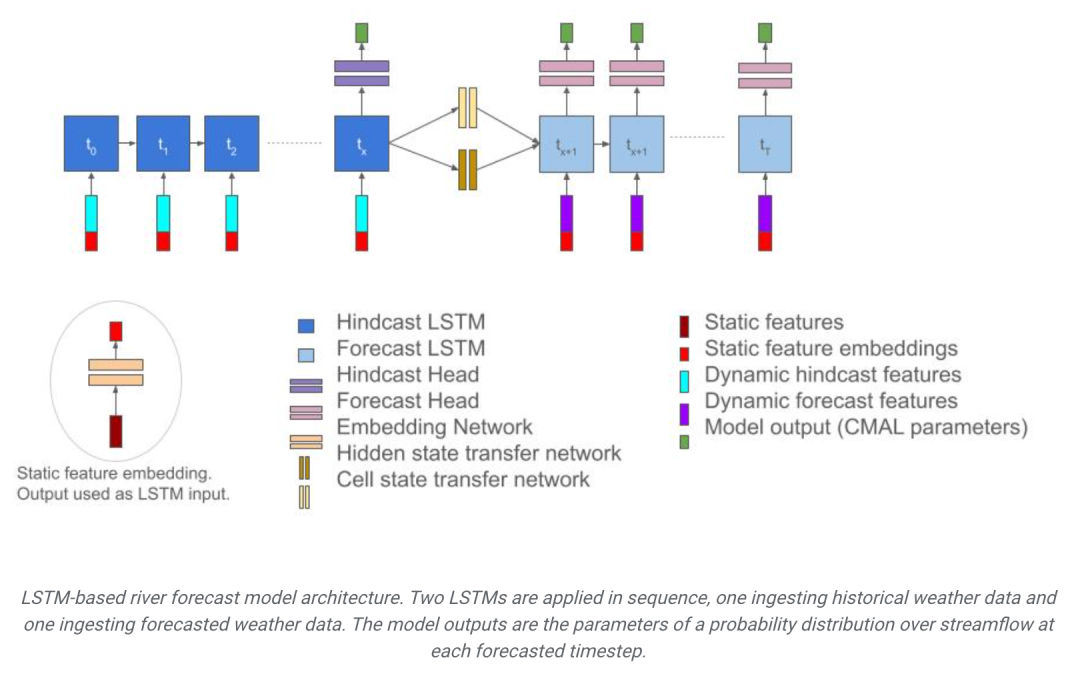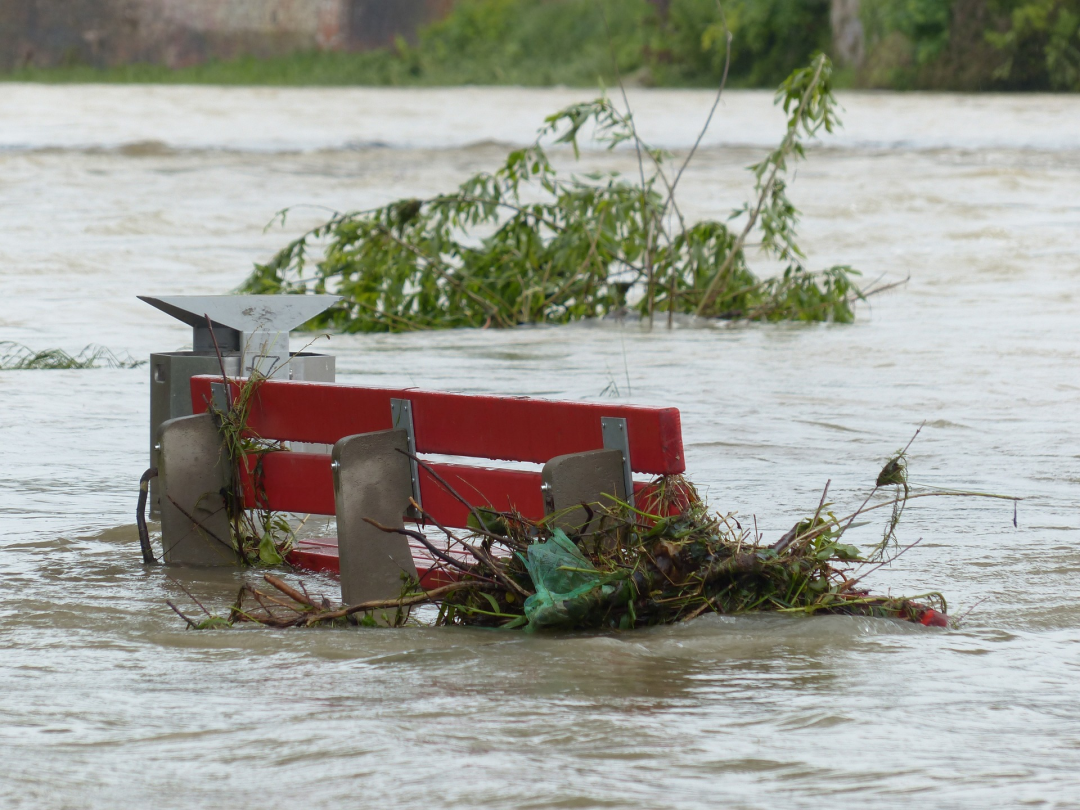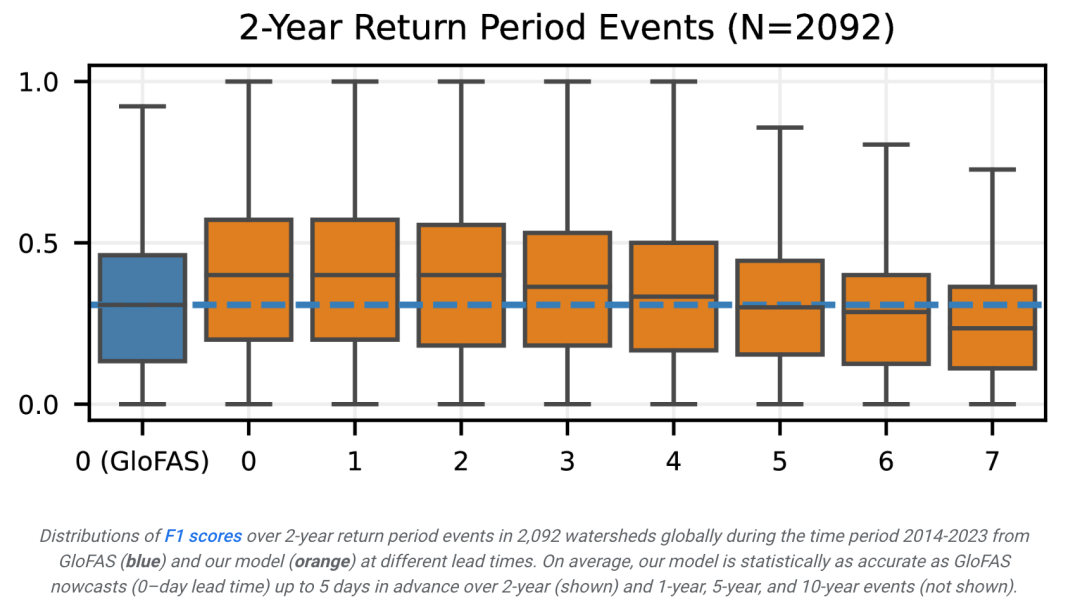Home >Technology peripherals >AI >Nature's big news: AI defeats the most advanced global flood warning system and predicts river floods 7 days in advance, saving thousands of lives every year
Nature's big news: AI defeats the most advanced global flood warning system and predicts river floods 7 days in advance, saving thousands of lives every year
- 王林forward
- 2024-03-23 14:56:35774browse
Floods are one of the most common natural disasters, with nearly 1.5 billion people (19% of the world’s population) at risk. Floods not only cause huge physical damage but also cause economic losses of approximately US$50 billion globally each year.
In recent years, human-caused climate change has further increased the frequency of flooding in some areas. However, current forecasting methods mainly rely on observation stations built along rivers, which are unevenly distributed around the world. This makes it more difficult to predict unmeasured rivers, and its negative impacts are mainly reflected in developing countries. Upgrading early warning systems so that these groups have access to accurate, timely information could save thousands of lives each year.
So, how to achieve reliable flood forecasting on a global scale? Artificial intelligence (AI) models may have great promise.
Gray Nearing and team members from Google Research’s flood prediction team have successfully developed an artificial intelligence model trained using 5,680 existing gauges. This model can accurately predict daily runoff in ungauged watersheds over the next seven days, providing important data support for flood warning and prevention. Gray Nearing noted that the technology was developed to improve the ability to predict flood risks so that necessary measures can be taken in a timely manner to reduce the impact of potential disasters. A successful demonstration of this research result
Then, they tested this artificial intelligence model against the Global Flood Alert System (GloFAS), the world's leading short-term and long-term flood prediction software. The results show that the model is comparable or even better than existing systems in terms of same-day prediction accuracy.
Additionally, the model demonstrated a level of accuracy that is comparable or even higher than GloFAS in predicting extreme weather events with a return window of five years, compared to GloFAS in predicting events with a one-year return window.
The relevant research paper is titled "Global prediction of extreme floods in ungauged watersheds" and has been published in the authoritative scientific journal Nature.
The research team pointed out that this model can provide early warning of small-scale and extreme flood events that may occur in unmeasured watersheds, and provides a longer warning time than past methods. This will help improve access to reliable flood warning information in developing country regions.
How does AI achieve 7 days in advance?
So, how can this artificial intelligence model give reliable flood forecasts?
The long short-term memory (LSTM) network was used as an artificial intelligence model in the study to predict the flow of the river. The model works similarly to the human brain and is able to predict future river flows by learning sequences of meteorological data. The model is divided into two parts: an encoder and a decoder. The encoder is responsible for processing input data, and the decoder is responsible for generating prediction results. In this way, the model can provide accurate and reliable river flow predictions, providing important support for water resources management and disaster prevention efforts.

River forecast model architecture based on LSTM. Two LSTMs are applied sequentially, one receiving historical weather data and the other receiving predicted weather data. The model output is the flow probability distribution parameters at each forecast time step.
First, the encoder is responsible for extracting information from meteorological data over a previous period. It understands changes in river flow from past weather conditions. It converts historical meteorological data into a form of information that can be used by decoders. By learning features and temporal patterns in meteorological data, the model develops an abstract understanding of past meteorological conditions, providing critical input for subsequent flow predictions.
The encoder receives a series of meteorological data (such as precipitation, temperature, radiation, etc.) as input and learns how to extract key feature information in these data. These characteristic information may include seasonal changes, meteorological events (such as heavy rains, high temperatures, etc.) and their impact on river flow.
At the same time, the encoder is able to capture the temporal dependencies between meteorological data. This means that it not only considers the meteorological conditions at the current moment, but also considers the meteorological change trends in the previous period. By learning from historical data, the encoder is able to understand the time series patterns of meteorological data and incorporate them into the model.
In the encoder, LSTM network is used to process time series data. LSTM has an internal memory unit that can remember past information and update the internal state based on current input. This enables the encoder to perform well in handling long-term dependencies and preserve important historical information during the modeling process.
Finally, the encoder converts the historical meteorological data into a potential representation that contains an understanding and summary of past meteorological conditions. This representation is the output of the encoder and is passed to the decoder for prediction of future traffic.
The decoder part then uses this information to predict river flow over the next few days. It takes into account current weather forecasts, as well as the impact of past weather on future flows. In this way, you can get the traffic forecast for the next week.

#The decoder is responsible for combining historical meteorological information and future predictions in the model, generating predictions of future river flow, and outputting the corresponding flow Probability distributions.
The decoder first receives a latent representation from the encoder, which contains an abstract understanding of the historical meteorological data. The decoder uses this information to understand the impact of past meteorological conditions on river flows and to establish links between historical data and future predictions.
The decoder also receives future weather forecast data as input. These forecast data usually include precipitation, temperature and other meteorological indicators in the next few days. The decoder combines historical information and future predictions to predict future river flows by learning the relationship between them.
After understanding historical meteorological conditions and future predictions, the decoder generates predictions of future river flow through an independent LSTM network. This network can be understood as a time series generator that generates traffic sequences based on past information and future predictions.
The decoder not only predicts future river flow values, but also outputs a probability distribution. Specifically, the model uses a one-sided Laplace distribution to describe the uncertainty of flow. When predicting the flow value at each time step, it outputs the parameters of a one-sided Laplace distribution rather than a determined value. . This enables the model to take into account the uncertainty in flow forecasts, providing more information for decision-making.
The final traffic prediction result is obtained by integrating the output of multiple decoder models. The model uses three independently trained decoder LSTM networks and then takes the median of their predictions, thereby reducing the variance of the predictions and improving the stability of the predictions.
What is the real effect?
The researchers collected a large amount of meteorological data and river flow data to train this model. The data comes from different data sources, including weather forecasts, historical records and geographical information. By normalizing the data, the model understands it correctly.
Then, the data is divided into two types: training set and test set. The training set is used to train the model, while the test set is used to evaluate the performance of the model. The researchers used a "cross-validation" approach to ensure the model worked effectively across time and locations.
Finally, the research team evaluated the performance of the model and compared it with existing traffic prediction models.
The research team used common error metrics to quantify the difference between model predictions and actual observations. Because the model predicts not just specific values of future flow, but also gives the uncertainty in the flow forecast, they used a Probabilistic Integral Transform (PIT) plot to evaluate the accuracy of the predicted distribution.
The research team also evaluated the performance of the proposed model by comparing it with other traffic prediction models. This includes traditional physical models and other machine learning models. By comparing the error indicators of different models, the advantages of the proposed model in terms of accuracy and reliability can be intuitively demonstrated.
In addition, the research team also used specific watersheds or rivers as case studies, applied the model in actual situations, and analyzed in detail the prediction performance of the model in different seasons and different climate conditions. . This helps evaluate the feasibility and stability of the model in practical applications.
In addition to quantitative indicators, the research team also conducted an in-depth analysis of the uncertainty of model predictions. This includes assessing the impact of different sources of uncertainty (such as uncertainty in input data, uncertainty in model structure, etc.) on forecast results, and how well models can still provide useful predictions in the presence of uncertainty.
The results show that the model exhibits high precision and recall, especially for events with short-term return periods. This means the model is able to accurately identify flood events and miss fewer events.
Combining precision and recall, the model achieved a higher F1 score on events with different return periods, indicating that it achieved a good balance between accuracy and comprehensiveness. balance.

Additionally, the model’s predictions are statistically significantly better than the baseline model via a two-sided Wilcoxon signed-rank test. This demonstrates the effectiveness of the model in flood prediction.
Cohen's d indicator shows that the effect of model performance improvement is significant, which further verifies the advantages of the model over traditional methods.
On hydrological indicators such as Nash–Sutcliffe efficiency and Kling-Gupta efficiency, the model also shows good prediction accuracy and sensitivity to changes in hydrological processes.
Shortcomings and prospects
However, this study also has some limitations.
For example, the sample used in the experiment may be small, limiting the generalizability and statistical power of the study results. There is a lack of diversity in the data sets used in the study, which may affect the generalization ability of the model. The model adopted has high complexity, which may increase the computational cost and limit its interpretability and convenience.
In addition, the research focuses on specific tasks or fields, which may limit the wide application of the method; this method lacks the evaluation of long-term impact, resulting in insufficient understanding of the performance of the model over time, and evaluation Standards may not fully reflect model performance; and the degree of improvement over existing technology may be relatively limited.
In this regard, the research team stated that future work is needed to further expand the coverage of flood forecasts to more locations around the world, as well as other types of flood-related events and disasters, including flash floods and Urban flooding. Artificial intelligence technology will also continue to play a key role in helping to advance scientific research and promote climate action.
The above is the detailed content of Nature's big news: AI defeats the most advanced global flood warning system and predicts river floods 7 days in advance, saving thousands of lives every year. For more information, please follow other related articles on the PHP Chinese website!

